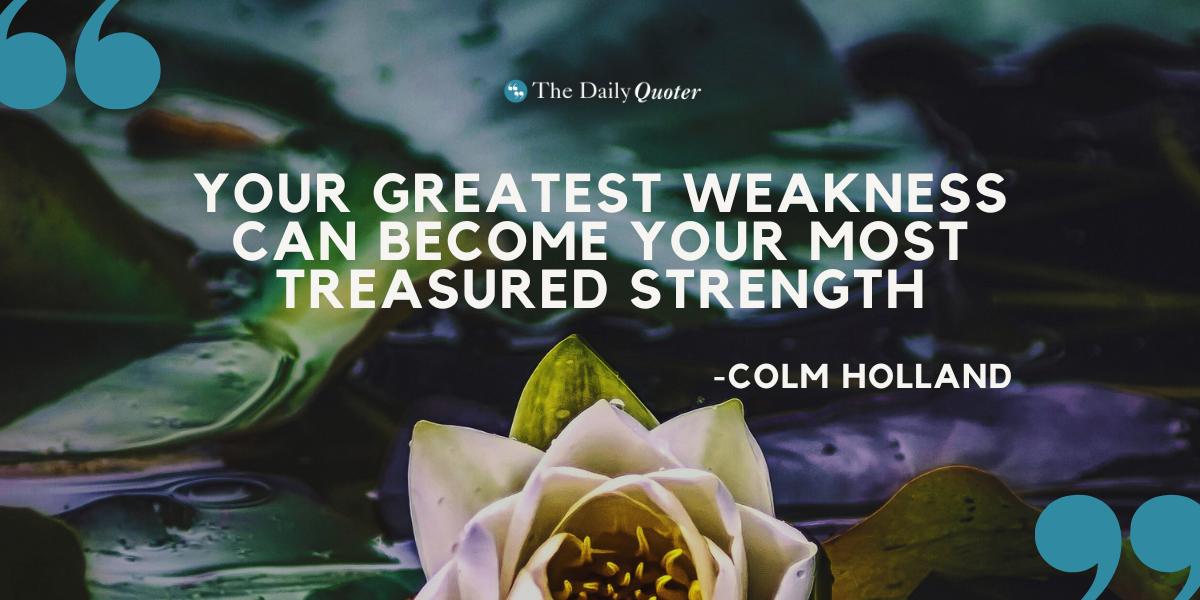
Colm Holland‘s powerful quote, “Your greatest weakness can become your most treasured strength,” resonates deeply with anyone who has ever stumbled on their path. It offers a glimmer of hope, suggesting that even our most ingrained flaws hold the potential for transformation and triumph. But how do we unlock this hidden potential and turn our weaknesses into strengths?
The first step lies in reframing our perspective. We often view weaknesses as burdens, limitations that hold us back. But what if we saw them differently? What if they were not roadblocks, but rather detours leading to unexpected destinations? This shift in mindset allows us to approach our weaknesses with curiosity and open-mindedness, instead of fear and self-criticism.
Every weakness, no matter how seemingly detrimental, holds within it a hidden gem. It might be a unique perspective, a heightened sensitivity, or an unwavering determination. For example, someone easily overwhelmed by details might possess incredible focus and analytical skills. Someone perceived as shy might be a thoughtful listener and a compassionate friend. Identifying these hidden strengths within our weaknesses is crucial for unlocking their true potential.
The Alchemy of Transformation:
Turning a weakness into a strength is not a passive process. It requires dedication, effort, and a willingness to step outside our comfort zone. This might involve seeking professional guidance, practicing new skills, or simply changing our internal dialogue. Remember, the journey is just as important as the destination. Celebrate small victories, learn from setbacks, and never give up on the potential within you.
Real-Life Transformations:
History is filled with individuals who have transformed their weaknesses into their greatest strengths. Nelson Mandela’s years of imprisonment fueled his unwavering determination to fight for equality. J.K. Rowling’s early rejections fueled her creativity and led to the birth of Harry Potter. Stephen King’s fear of writing became the driving force behind his prolific and successful career. These inspiring stories remind us that even the most daunting weaknesses can be overcome with the right mindset and dedication.
Embrace the Journey:
Remember, transforming weaknesses into strengths is a lifelong journey, not a one-time event. There will be challenges, setbacks, and moments of doubt. But by embracing the process, staying true to your values, and never losing sight of your potential, you can unlock the hidden strength within your weaknesses and create a life filled with purpose and fulfillment.
So, the next time you find yourself struggling with a weakness, remember Colm Holland’s words. Don’t see it as a burden, but as an opportunity for growth. Embrace the journey of transformation, and watch your greatest weakness blossom into your most treasured strength.
It’s a message about the potential for transformation within ourselves. Here are some ways to unpack and explore this idea:
The content below was originally paywalled.
Understanding weaknesses:
Identifying them: The first step is recognizing and acknowledging our weaknesses. This can be uncomfortable, but it’s crucial for growth. Are you easily distracted? Perhaps oversensitive to criticism? Prone to procrastination? Recognizing these aspects is key.
Reframing them: Instead of viewing weaknesses as limitations, consider them as potential growth areas. They represent opportunities to learn, develop, and improve.
Transforming weaknesses into strengths:
Leveraging their unique perspective: Each weakness also holds a potential strength within it. For example, someone who is sensitive to criticism might be highly attuned to others’ emotions, making them a good listener or counselor. Someone prone to procrastination might be highly creative and excel under pressure.
Actively working on them: Transformation doesn’t happen passively. It requires conscious effort and commitment. This could involve seeking help, practicing new skills, or adopting different mindsets.
Examples of this transformation:
Nelson Mandela: His imprisonment fueled his determination to fight for equality.
J.K. Rowling: Overcoming rejection of her early Harry Potter manuscripts led to her incredible success.
Stephen King: Overcoming his fear of writing through sheer persistence made him a prolific and celebrated author.
Remember:
This transformation is a journey, not a destination. There will be setbacks and challenges.
The key is to embrace the process, learn from mistakes, and never stop striving for growth.
Celebrate your progress, no matter how small.

Leave a Reply